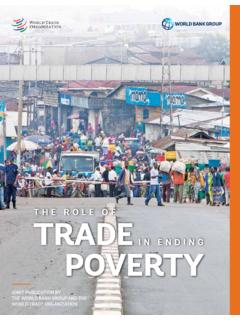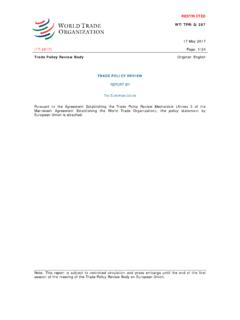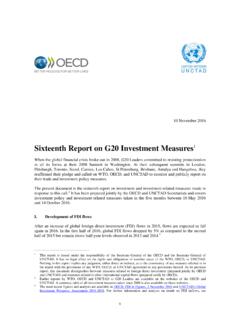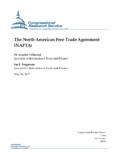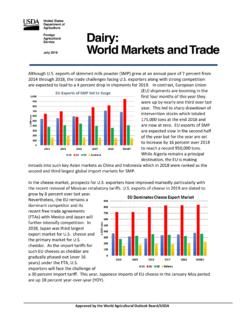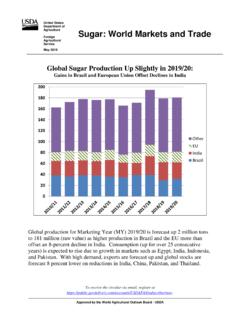Transcription of B G LOBALIZATION AND TRADE - World Trade Organization
1 II B GLOBALIZATION AND TRADE . B GLOBALIZATION AND TRADE . While there is no universally agreed definition of 1. TRENDS IN GLOBALIZATION. globalization, economists typically use the term to refer to international integration in commodity, International TRADE after WWII entered a long period capital and labour markets (Bordo et al., 2003). Using of record expansion with World merchandise exports integration in these markets as the benchmark, it is rising by more than 8 per cent per annum in real clear that globalization is not a new phenomenon. terms over the 1950-73 period. TRADE growth slowed Since the mid-19th century, there have been at least thereafter under the impact of two oil price shocks, two episodes of globalization (Baldwin and Martin, a burst of inflation caused by monetary expansion 1999).
2 And inadequate macroeconomic adjustment policies. In the 1990s, TRADE expanded again more rapidly, The first episode began around the mid-19 th century partly driven by innovations in the information and ended with the commencement of World War I technology (IT) sector. Despite the small contraction (WWI). The second episode began in the aftermath of TRADE caused by the dotcom crisis in 2001, the of World War II (WWII) and continues today. In average expansion of World merchandise exports both these episodes of globalization, rapid TRADE continued to be high averaging 6 per cent for the and output growth went together with major shifts 2000-07 period.
3 For the entire 1950-2007 period, in the relative size of the economies involved. One TRADE expanded on average by per cent, which is valuable lesson from history is that globalization has much stronger than in the first wave of globalization not been a smooth process. It has often been marked from 1850 to As dollar prices expanded much by periods of accelerated integration (as observed faster after WWII than before WWI the nominal in the 19th century and in the second half of the TRADE expansion of the former period is more than 20 th century) and by periods of dramatic reversals twice as fast as in the earlier period ( per cent (as in the inter-war period) sometimes with costly versus per cent per annum).
4 Consequences. The most dynamic traders in the 1950-73 period The two most recent episodes of globalization were were the west European countries and Japan (see characterized by increased integration in TRADE , Chart 1). Post WWII reconstruction and the Korean capital flows and movement of labour, although War provided a major stimulus to Japanese and there are differences in the importance that each European exports in the early 1950s. Thereafter, of these elements played in the two episodes (see European integration sustained the expansion Table 1). of intra-European TRADE . The share of intra-west European TRADE in World TRADE rose from per cent in 1953 to per cent in 1973 while extra- regional TRADE expanded somewhat less than global Table 1.
5 Globalization waves in the 19th and 20th century (Percentage change unless indicated otherwise). World 1850-1913 1950-2007 1950-73 1974-2007. Population growth a GDP growth (real) a Per capita a TRADE growth (real) Migration (net) Million US, Canada, Australia, NZ (cumulative) a US, Canada, Australia, NZ (annual) a Industrial countries (less Japan) (cumulative) .. Global FDI outward stock, year 1982 2006. FDI as % of GDP ( World ) .. a Refers to period 1870-1913. Source: Maddison (2001), Lewis (1981), UNCTAD (2007), WTO (2007a). 15. World TRADE REPORT 2008. TRADE . While the United States remained Japan's lost almost all their gains when oil prices fell back largest export market throughout that period, thereafter.
6 In 1993, after the disintegration of the Japanese export shipments grew more rapidly to Soviet Union and the demise of the Council of western Europe and the Asian newly industrialized Mutual Economic Assistance (CMEA) industrial economies (NIEs). 2 From the early 1960s onwards, countries' ( western Europe, North America and the six NIEs followed an outward oriented TRADE Japan) share of World merchandise exports reached policy and succeeded in sharply increasing their a peak, in excess of 70 per cent. Together with the merchandise exports. In the two decades following six NIEs, they accounted for more than 80 per cent 1963 the share of the Asian NIEs rose from per of World TRADE in 1993.
7 Cent to per cent of World merchandise exports. These economies initially excelled in exporting In the 1990s, Japan's share in World exports started textiles but diversified later into exports of consumer to shrink significantly owing to the competitive electronics and IT products. pressure exerted by the NIEs and China. The stimulus provided by the creation of the North The dominant share of the United States in World American Free TRADE Agreement (NAFTA) in 1994. TRADE in the early 1950s was eroded in subsequent was not sufficient to reverse the downward trend in decades. While the automotive agreement between the share of Canada and the United States in global the United States and Canada in 1965 strengthened TRADE .
8 Similarly, the European integration process intra-North American TRADE , the combined share which continued to deepen and expand to cover of the two countries in World TRADE shrank by 10 the central European countries and the Baltic states percentage points between 1953 and 1973 (see Chart could not halt the relative decline of European 1). During the following two decades, the share exports. of regions in World merchandise exports varied, largely due to the fluctuations of commodity prices The reduced share of the industrial countries can and exchange rates. The oil-exporting developing be attributed first to the rise of China, the recovery countries (especially those in the Middle East) of the Commonwealth of Independent States (CIS)3.
9 Increased their share between 1973 and 1983 but and in more recent years to the boom in commodity Chart 1. Share of major exporters in World merchandise TRADE , 1953-2006. (Percentage). 100. 90. 80. China 70. NIEs(6). 60. United States / Canada 50. Japan 40. Extra- TRADE 30. Western Europe 20. Intra- TRADE 10. 0. 1953 1963 1973 1983 1993 2003 2006. Note: Break in series between 1993 and 2003. Western Europe becomes Europe including Eastern Europe and Baltic States. NIEs - Newly Industrialised Economies comprising Chinese Taipei; Hong Kong, China; Rep. of Korea; Malaysia; Singapore and Thailand. Source: WTO Secretariat. 16. II B GLOBALIZATION AND TRADE .
10 Prices which boosted the shares of Africa, the Among the contributory factors were economic Middle East and Central/South America, regions policy re-orientation in Mexico and China in the which export mostly minerals and other primary early 1980s combined with the fall of the Berlin products. Increased competition from China in the Wall and the dissolution of the Soviet Union a World TRADE of manufactured goods was concentrated decade later. initially in textiles TRADE and other labour-intensive goods, such as footwear and toys, but expanded The prominent role played by the industrial quickly into consumer electronics and IT goods. economies in World merchandise exports up to the More recently, China's biggest gains in market 1990s was closely linked to their very large share share were in iron and steel products.
